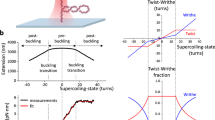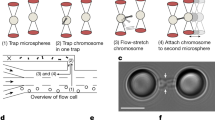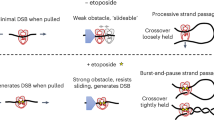Abstract
Type II DNA topoisomerases are ubiquitous ATP-dependent enzymes capable of transporting a DNA through a transient double-strand break in a second DNA segment1. This enables them to untangle DNA2,3,4,5,6 and relax the interwound supercoils (plectonemes) that arise in twisted DNA7. In vivo, they are responsible for untangling replicated chromosomes and their absence at mitosis or meiosis ultimately causes cell death8,9. Here we describe a micromanipulation experiment in which we follow in real time a single Drosophila melanogaster topoisomerase II acting on a linear DNA molecule which is mechanically stretched and supercoiled10,11,12,13. By monitoring the DNA's extension in the presence of ATP, we directly observe the relaxation of two supercoils during a single catalytic turnover. By controlling the force pulling on the molecule, we determine the variation of the reaction rate with the applied stress. Finally, in the absence of ATP, we observe the clamping of a DNA crossover by a single topoisomerase on at least two different timescales (configurations). These results show that single molecule experiments are a powerful new tool for the study of topoisomerases.
This is a preview of subscription content, access via your institution
Access options
Subscribe to this journal
Receive 51 print issues and online access
$199.00 per year
only $3.90 per issue
Buy this article
- Purchase on Springer Link
- Instant access to full article PDF
Prices may be subject to local taxes which are calculated during checkout




Similar content being viewed by others
References
Wang,J. C. Moving one DNA double helix through another by a type II DNA topoisomerase: the story of a simple molecular machine. Q. Rev. Biophys. 31, 107–144 (1998).
Liu,L. F., Liu,C. C. & Alberts,B. M. Type II DNA topoisomerases: enzymes that can unknot a topologically knotted DNA molecule via a reversible double-stranded break. Cell 19, 697–707 (1980).
Hsieh,T. Knotting of the circular duplex DNA by type II DNA topoisomerase from D. melanogaster . J. Biol. Chem. 258, 8413– 8420 (1983).
Roca,J. & Wang,J. C. The capture of a DNA double helix by an ATP-dependent protein clamp: a key step in DNA transport by type II DNA topoisomerase. Cell 71, 833– 840 (1992).
Roca,J., Berger,J. M. & Harrison, S. C. & Wang,J. C. DNA transport by a type II topoisomerase: Direct evidence for a two-gate mechanism. Proc. Natl Acad. Sci. USA 93, 4057– 4062 (1996).
Rybenkov,V. V., Ullsperger,C. Vologodskii, A. V. & Cozzarelli,N. R. Simplification of DNA topology below equilibrium values by type II topoisomerases. Science 277, 690–693 (1997).
Osheroff,N., Shelton,E. R. & Brutlag, D. L. DNA topoisomerase II from D. melanogaster: relaxation of supercoiled DNA. J. Biol. Chem. 258, 9536–9543 (1983).
Uemura,T. & Yanagida,M. Mitotic spindle pulls but fails to separate chromosomes in type II DNA topoisomerase mutants: uncoordinated mitosis. EMBO J. 5, 1003– 1010 (1986).
Ishida,R. et al. Inhibition of DNA topoisomerase II by ICRF-193 induces polyploidization by uncoupling chromosome dynamics from other cell cycle events. J. Cell Biol. 126, 1341–1351 (1994).
Strick,T. R., Allemand,J. F., Bensimon, D., Bensimon,A. & Croquette,V. The elasticity of a single supercoiled DNA molecule. Science 271, 1835– 1837 (1996).
Strick,T. R., Allemand,J. F., Bensimon, D. & Croquette,V. The behavior of super-coiled DNA. Biophys. J. 74, 2016–2028 (1998).
Strick,T. R., Croquette,V. & Bensimon, D. Homologous pairing in stretched supercoiled DNA. Proc. Natl Acad. Sci. USA 95, 10579– 10583 (1998).
Allemand,J. F., Bensimon,D., Lavery,R. & Croquette,V. Stretched and overwound DNA forms a Pauling-like structure with exposed bases. Proc. Natl Acad. Sci. USA 95, 14152– 14157 (1998).
Landau,L. & Lifchitz,E. Theory of Elasticity (Mir Editions, Moscow, 1967).
Moroz,J. D. & Nelson,P. Torsional directed walks, entropic elasticity and DNA twist stiffness. Proc. Natl Acad. Sci. USA 94, 14418–14422 (1998).
Bouchiat,C. & Mézard,M. Elasticity model of a supercoiled DNA molecule. Phys. Rev. Lett. 80, 1556– 1559 (1998).
Brown,P. O. & Cozzarelli,N. R. A sign inversion mechanism for enzymatic supercoiling of DNA. Science 206, 1081–1083 (1979).
Hua,W., Young,E. C., Fleming,M. L. & Gelles,J. Coupling of kinesin steps to ATP hydrolysis. Nature 388, 390–393 (1997).
Harkins,T. T. & Lindsley,J. E. Pre-steady-state analysis of ATP hydrolysis by Saccharomyces cerevisiae DNA topoisomerase II. 1. A DNA-dependent burst in ATP hydrolysis. Biochemistry 37, 7292–7298 (1998).
Harkins,T. T., Lewis,T. J. & Lindsley, J. E. Pre-steady-state analysis of ATP hydrolysis by Saccharomyces cerevisiae DNA topoisomerase II. 2. Kinetic mechanism for the sequential hydrolysis of two ATP. Biochemistry 37, 7299–7312 (1998).
Wang,M. D. et al. Force and velocity measured for single molecules of RNA polymerase. Science 282, 902–907 (1998).
Visscher,K., Schnitzer,M. J. & Block, S. M. Single kinesin molecules studied with a molecular force clamp. Nature 400, 184– 189 (1999).
Zechiedrich,E. L. & Osheroff,N. Eukaryotic topoisomerases recognize nucleic acid topology by preferentially interacting with DNA crossovers. EMBO J. 9, 4555–4562 (1990).
Roca,J., Berger,J. M. & Wang,J. C. On the simultaneous binding of eukaryotic DNA toposiomerase II to a pair of double-stranded DNA helices. J. Biol. Chem. 268, 14250–14255 (1993).
Froelich-Ammon,S. J. & Osheroff,N. Topoisomerase poisons: harnessing the dark side of enzyme mechanism. J. Biol. Chem. 270, 21429–21432 ( 1995).
Acknowledgements
We thank B. Maier and J.-F. Allemand for helpful comments and O. Hyrien, J.-L. Sikorav, M. Duguet, V. Rybenkov, N. Crisona and N. Cozzarelli for stimulating conversations. We also thank N. Cozzarelli for a gift of cloned topo II. T.R.S. was supported by a CNRS BDI fellowship.
Author information
Authors and Affiliations
Rights and permissions
About this article
Cite this article
Strick, T., Croquette, V. & Bensimon, D. Single-molecule analysis of DNA uncoiling by a type II topoisomerase . Nature 404, 901–904 (2000). https://doi.org/10.1038/35009144
Received:
Accepted:
Issue Date:
DOI: https://doi.org/10.1038/35009144
This article is cited by
-
Supercoiled DNA Minicircles under Double-strand Breaks
Chinese Journal of Polymer Science (2024)
-
Etoposide promotes DNA loop trapping and barrier formation by topoisomerase II
Nature Chemical Biology (2023)
-
Topoisomerase II and etoposide — a tangled tale
Nature Chemical Biology (2023)
-
Chromatinization modulates topoisomerase II processivity
Nature Communications (2023)
-
A review on particle assembly in standing wave acoustic field
Journal of Nanoparticle Research (2022)
Comments
By submitting a comment you agree to abide by our Terms and Community Guidelines. If you find something abusive or that does not comply with our terms or guidelines please flag it as inappropriate.



